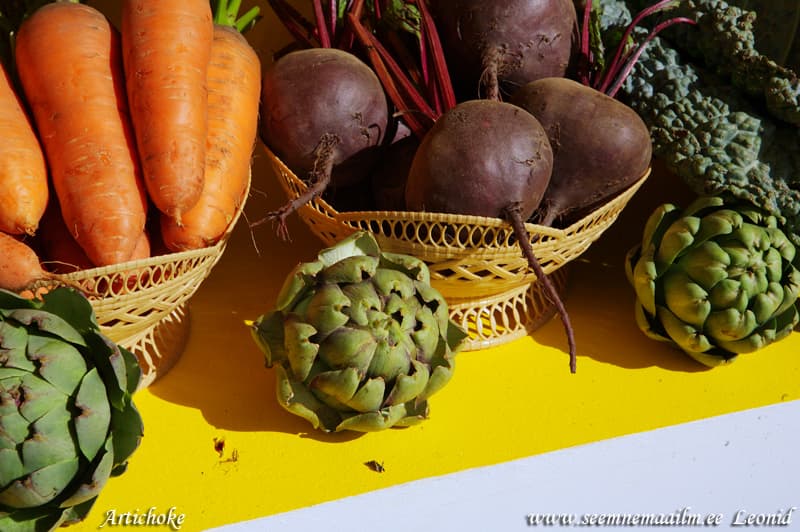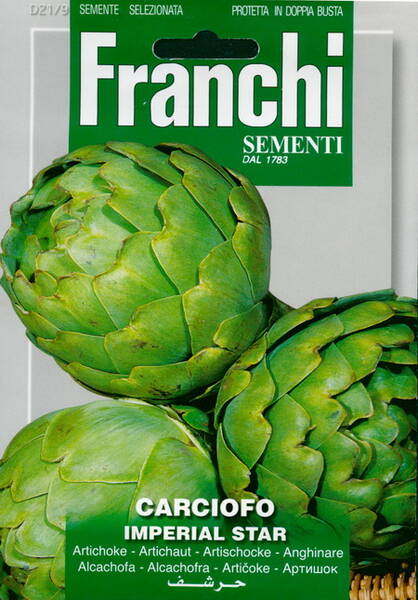Ex Tax: 1.65€
Medium early variety. Plant height up to 150 cm.
Sowing time: March, April.
Seedling disembarkation time: June.
Harvesting time: August-September.
Planting method: seedlings.
Distance between plants: 40 cm.
Row spacing: 70 cm.
Officinal (medicinal) plant, beneficial plant.
Winter hardiness zone: Z6-Z10.

* The artichoke is a very healthy, vitamin-rich delicacy culture. Inflorescences-baskets with a fleshy receptacle and large, juicy, numerous leaves-wrappers are used for food.
Cut off the baskets with a part of the peduncle 3-5 cm long before flowering, when the scales in the upper part of the wrapper are just beginning to diverge.
The heads are used in salads, minced meat, mashed potatoes, sauces and canned food.
It is worth planting this plant on your site only in order to taste an extraordinary dish - boiled artichokes, to find out what it is and what it is really eaten with.
In addition to growing this unusually useful crop with our own hands in our garden, and then carrying out the sacrament of cooking in our own kitchen, we probably have no other way.
For some reason, the artichoke is little grown in Russia, and you can not even try dishes from it in every restaurant.
But this is a very popular vegetable in France, America, Italy. As a magnificent delicacy, it was known even to the ancient Greeks and Romans!
The artichoke was initially grown only as an ornamental and medicinal plant.
It has now been proven that the use of this vegetable in food prevents the development of atherosclerosis, lowers the level of cholesterol in the blood.
The juice and decoction of the leaves of the plant contains substances that have a choleretic and diuretic effect and therefore artichokes are very useful for liver and kidney disease.
For the same purpose, they also use water after scalding the baskets with the addition of fresh egg yolks. Everything goes into action with this healing vegetable.
For cooking at the artichoke, unblown inflorescences-baskets are used, or rather, their fleshy receptacle (bottom) and juicy lower parts of the inflorescence scales.
Fresh young artichokes have a delicate, amazing taste, reminiscent of the taste of a young walnut, and are used in salads,
and in boiled ones - not only as an independent dish, but also as a dietary side dish.
Indeed, the artichoke contains so many useful substances: proteins and fats, vitamins and trace elements, as well as inulin - a starch substitute necessary for diabetes.
Before preparing an artichoke, the inflorescence must be properly processed.
This is a whole art: an artichoke is not a potato!
The stem is carefully cut off at the very base of the inflorescence head, and the scales are trimmed from above with scissors, cutting off the sharp ends.
All slices are immediately moistened with lemon juice so that they do not darken. From the middle of the basket with a sharp metal spoon, remove the ovaries of flowers.
After that, the prepared artichokes are washed well and tied with twine or threads so that the scales do not disintegrate during cooking,
and immediately dipped into boiling water, otherwise the baskets will darken.
What is the plant itself?
Anyone who knows what a thistle looks like - a harmful thorny weed - can easily imagine an artichoke (only the latter is much larger, more beautiful and incomparably healthier).
Large pinnately dissected dark green or silvery leaves, pubescent on the underside, adorn a strong stem up to one and a half to two meters high.
And branchy shoots are crowned with crowns of inflorescences the size of a good tomato - a real sleek aristocrat of any garden!
About a kilogram of delicacy inflorescences are collected from one bush. And dried artichoke stems are an excellent material for making winter bouquets.
Despite its imposing and arrogant appearance, the artichoke is quite unpretentious. This perennial giant grows well in home gardens and is able to tolerate small frosts.
In the middle lane and to the south, with good shelter, the artichoke can even overwinter in the soil.
But in the northern regions, you can grow it as a perennial crop, transferring the rhizome along with a lump of earth to the basement for storage in the winter,
and planting it again in the ground in the spring. And already at the beginning of summer you will harvest the first harvest of amazing artichokes.
To obtain baskets of good quality in the first year, no more than three flowering stems and three to four inflorescences on each are left on the plant.
Little secret: to make the heads larger, the stems under them are pierced with wooden pins at the moment when the inflorescences reach half of their size.
We advise you to eat artichokes not only with reverence, but also with milk sauce!
And real gourmets will surely like the recipe with mussels and oranges.
Eng.: Garden Artichoke, Globe Artichoke.
Enjoy:
add 2 inches of water to a large saucepan and bring to a boil. Place the artichokes in the pan, cover and simmer for 40 minutes.
Turn the artichokes over to drain.
In a medium saucepan, bring the wine to a boil with 4 tablespoons of water. Add the fresh mussels, cover and steam for 3 minutes, until they open.
Reserve the broth and transfer the mussels to a bowl (discard any that haven’t opened and remove the shells from the rest).
For the garnish, strain the broth through cheesecloth into a small saucepan and simmer for 2 minutes. Stir in the breadcrumbs.
Place everything in a small bowl and add the pepper puree, crushed garlic, vinegar, oil, salt, black pepper and cayenne pepper.
In a large bowl, combine the mussels, potatoes, orange segments, and half of the garnish.
Spread the artichoke leaves open to reveal the soft center, and scoop it out with a teaspoon.
Transfer the artichokes to plates and divide the filling between them. Serve the remaining garnish separately.












